Comptroller Kevin Lembo Archive > News
COMPTROLLER LEMBO PROJECTS $44.6-MILLION DEFICIT DUE TO SLOW INCOME TAX WITHHOLDING AND CAUTIOUS OUTLOOK ON FINAL PAYMENTSComptroller Kevin Lembo today announced that, due to slow income tax withholding revenue and concerns about final April payments, he is projecting that the state could end the current fiscal year with a $44.6-million deficit.
Lembo once again cautioned that earlier surplus projections relied on the optimistic view that final income tax payments in April will outperform estimated income tax payments collected earlier in the fiscal year, despite historic trends, due to certain stock market changes.
In a letter to Gov. Dannel P. Malloy, Lembo said that he agrees with a recent income tax projection by the Office of Fiscal Analysis, which is $60 million below the January consensus forecast relied on in recent months.
“The withholding portion of the income tax, which accounts for over 60 percent of total income tax receipts, has been weakening in recent months,” Lembo said. “In addition, estimated income tax payments through February were below last fiscal year’s receipts. The final income tax receipts will be available later in April. As in past fiscal years, it is likely that the final April payments will alter General Fund projections.
“I would be happy to be wrong,” Lembo said.
Lembo explained that it’s typical for April final payments to trend in the same direction as the estimated payments made during the fiscal year. However, because of stock market corrections and subdued bonus payments in the 2015 tax year, a large number of taxpayers may be eligible to utilize safe harbor provisions of the tax code. The safe harbor provisions allow taxpayers to delay the payment of their full 2016 tax liability until April of 2017 (rather than incorporating the payment into their fourth-quarter 2016 estimated payments).
While there may be reason to hope that - due to the safe harbor provisions - final payments will trend higher than estimated payments - Lembo said it’s better to exercise caution.
“I am concerned that these delayed payments may not be sufficient to reach the OPM (Office of Policy and Management) estimate,” Lembo said.
As for spending, Lembo said he projects that spending will exceed the budget plan by $18.1 million, which is somewhat higher than what OPM is projecting because Lembo said he believes ongoing settlement payments in the case of SEBAC v. Rowland have the potential to outpace initial budget plans.
“However, it should be noted that total General Fund spending through February was trending below both of these spending projections,” Lembo said. “If this trend holds through the remainder of the fiscal year, expenditures should be at or below the budget target, thus reducing the deficit projection.
“Connecticut’s overall budget performance is ultimately dependent upon the performance of the national and state economies,” Lembo said.
Lembo pointed to latest available economic indicators from federal and state Departments of Labor and other sources that show:

• In Fiscal Year 2016 the withholding portion of the income tax increased 3.4 percent from the prior fiscal year. Through February of Fiscal Year 2017, these receipts were up 1.8 percent from last year. Adjusting for timing differences between fiscal years in deposit days by month, the withholding tax trend has been running below last fiscal year and decelerating in recent months.
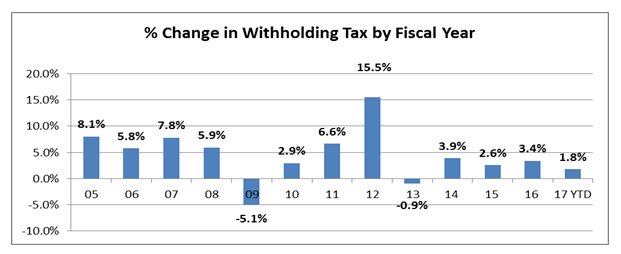
• According to 2016 benchmark revisions by the U.S. Bureau of Labor
Statistics, Connecticut lost 200 jobs in calendar year 2016. After strong 1st
quarter employment growth, the employment situation in the state became more
erratic. The final quarter of 2016 posted a net loss of jobs.
• Coming into 2017, Connecticut gained 6,500 jobs in January and lost 1,600 jobs
in February. Over the past 12 months the state has added 2,100 payroll positions
to a level of 1,682,400, which is below the pre-recession peak by 30,900 jobs.
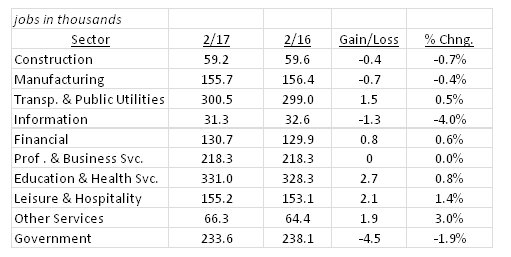
• U.S. employment has been advancing at a rate of 1.6 percent over the
12-month period ending in February; Connecticut’s employment growth has been 0.1
percent over that same period.
• Connecticut’s unemployment rate was 4.7 percent in February; the national
unemployment rate was also 4.7 percent. Connecticut’s unemployment rate has
continued to decline from a high of 9.5 percent in October 2010. There were
89,500 unemployed job seekers in Connecticut in February. A low of 36,500
unemployed workers was recorded in October of 2000. The number of unemployed
workers hit a recessionary high of 177,200 in December of 2010.
• All of the employment and related data must be considered in light of the
erosion in the state’s total population over recent years. According to U.S.
census data, Connecticut saw a decline in population of 8,278 residents between
July 1, 2015 and July 1, 2016. Connecticut was one of only eight states to
experience a decline in population during this period. Connecticut has now
posted three consecutive years of population decline.
![]()
• Average hourly earnings at $31.30, not seasonally adjusted, were up $0.98, or
3.2 percent, from the February 2016 hourly earnings estimate. The resultant
average private-sector weekly pay amounted to $1,032.9, up $29.31, or 2.9
percent higher than a year ago.
• The Consumer Price Index (CPI-U) was 2.7 percent in February.
• According to a March 28 release from the Bureau of Economic Analysis,
Connecticut’s personal income grew by 3 percent between 2015 and 2016. This
ranked Connecticut 33rd nationally in 2016 income growth. Connecticut had the
slowest rate of growth in New England. However, Connecticut ranked number one
nationally in per capita personal income in 2016 with income of $71,033.
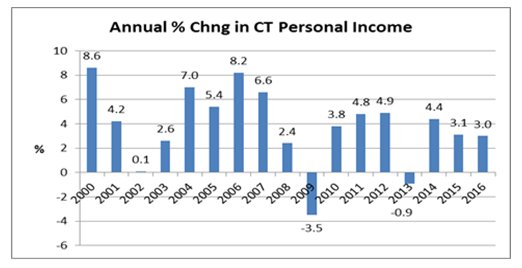
• Connecticut’s 4th quarter results for 2016 were better than the full year
results. The 4th quarter growth annualizes to a rate closer to 4 percent, which
ranked the state at 21 nationally for 4th quarter growth.
• Results for the 1st quarter of 2017 will be available on June 27.

• According to a March 22 release from CT Realtors, Connecticut single-family
residential home sales decreased by 4.2 percent in February 2017 from the same
month a year earlier. The median sales price of a home declined by 2.2 percent
to $225,000. This is a single month reversal to a prevailing trend. Connecticut
has been in a sustained period of sales volume gains since 2012; prices were
also rebounding in recent months. Townhouse and condominium sales also declined
with the median price remaining flat.
• The National Association of Realtors (NAR) reported that U.S. sales of
existing homes including condominiums expanded by 5.4 percent from February of
last year. The median price was up 7.7 percent to $228,400 from last February.
• With mortgage rates moving up, many economists have forecasted that 2017 will
be a slower year for the housing market than 2016. Some of the strongest sales
numbers in more than a decade were seen in 2016.
Consumers
• Retail spending growth advanced 0.1 percent in February from the previous
month, and 5.7 percent from February of 2016. Just four of the 13 major retail
categories saw gains in February sales.
• The largest gains were in building material and gardening equipment, and
non-store retailers; the largest losses were in electronics and appliance stores
and department stores.
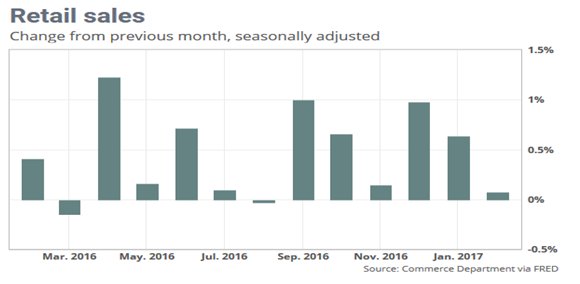
• The results in February were held down in part by a 0.2-percent drop in
sales at auto dealers. Auto purchases account for about one-fifth of all retail
spending.
• Some of February’s slow growth is being attributed to the slow pace of federal
tax refunds. The refund process is running significantly behind the pace of past
years. Economists are expecting much stronger March sales results.
• The University of Michigan said Friday that its preliminary index of sentiment
increased to 97.6 in March from 96.3 in February. Americans were more satisfied
than any time in 16 years with the current state of their finances and the
economy. Consumers expressed more confidence in their current economic well
being than in their expectations for the future.

• According to TransUnion’s Industry Insight report for the 4th quarter of
2016, the average mortgage balance reached a post-recession high of $194,415 in
that quarter. The mortgage delinquency rate concluded 2016 at 2.28 percent, and
has now declined every quarter on a quarter-over-quarter basis since the 3rd
quarter of 2013.
• The average credit card balance per consumer grew 2.8 percent to $5,486, up
from $5,337 at year-end 2015, which was the highest level since $5,609 in the
4th quarter of 2010. The credit card delinquency rate reached 1.79 percent in
the 4th quarter of 2016, an increase of 12.6 percent from a year ago. The credit
card delinquency rate remains more than a full point below its peak in the 4th
quarter of 2009 when it hit 2.97 percent.
• The average auto balance per consumer also rose slightly to $18,391, up from
$18,004 in the 4th quarter of 2015. The auto delinquency rate reached 1.44
percent to close 2016, a 13.4-percent increase from a year ago. Auto delinquency
is at its highest level since the end of 2009.
• The Federal Reserve Bank reported on March 7 that in January, consumer credit
increased at a seasonally adjusted annual rate of 2.75 percent. Revolving credit
decreased at an annual rate of 4.5 percent, while non-revolving credit increased
at an annual rate of 5.5 percent. January's drop in revolving credit may be a
correction from the previous November's unusually large revolving credit
increase of $11.8 billion.
Business and Economic Growth
• According to the March 30 third estimate from the Bureau of Economic
Analysis, real GDP in the 4th quarter of 2016 grew at a 2.1-percent annual rate.
This is an improvement from the second estimate that put growth at 1.9 percent.
The growth rate in the 3rd quarter was 3.5 percent.
• The deceleration in real GDP in the fourth quarter reflected downturns in
exports and in federal government spending, an acceleration in imports, and a
deceleration in nonresidential fixed investment that were partly offset by
accelerations in private inventory investment and in personal consumption
expenditures, and upturns in residential fixed investment and in state and local
government spending.
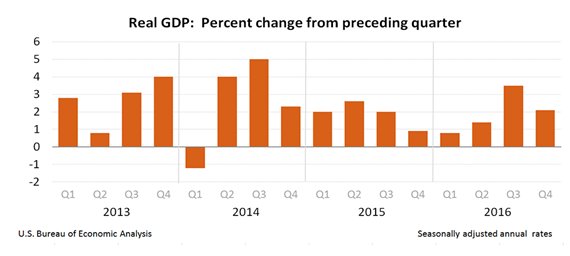
• Corporate profits after tax, without inventory valuation and capital
consumption adjustments, rose 3.7 percent from the prior quarter to a seasonally
adjusted annual rate of $1.741 trillion in the fourth quarter. It was the fourth
consecutive quarter of profits growth.

• For all of 2016, profits rose 4.3 percent after falling 8.5 percent in
2015. Earnings fell in 2015 as exports declined on a strengthening dollar,
energy prices and other commodity prices softened and global growth weakened.
But oil prices stabilized last year and the global outlook has brightened,
helping bolster U.S. businesses.
• According to the Commerce Department’s March 27 report, durable goods orders
rose 1.7 percent in February, topping economists’ expectations of a 1.2 percent
increase and following January’s revised 2.3-percent gain. It was another strong
month for the transportation sector, with commercial aircraft orders increasing
47.6 percent.
• Durable goods orders so far this year are running 1.6 percent higher than in
the first two months of 2016. Economists note that the report indicates that
manufacturers are steadily recovering from a rough patch that began in 2015 when
slower economic growth worldwide cut into demand for U.S. factory goods.
• The service-sector, which is the largest sector of the economy, hit a six
month low in March with a reading of 52.9 according to the Markit Flash U.S.
Services PMI Business Activity Index. The increase in new work orders for
service providers rose at its weakest level in 12 months. Employment gains
continued to ease from the 15 month high hit in December 2015.
• The Markit Composite PMI for all sectors also weakened in March.
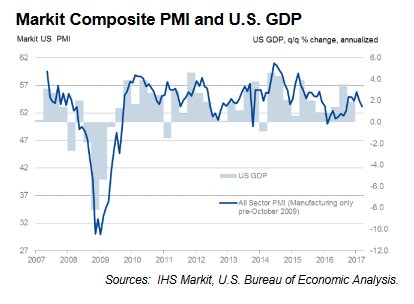
• The Department of Labor’s Business Economic Scorecard tracks the up and down movement in some key indicators for the state including: housing permits, air cargo, exports, gaming slots, visits to major attractions, air passenger count, the CT manufacturing production index and average weekly manufacturing hours. As the graph shows, the current recovery has not been as strong as the last recovery period. Between late 2003 and 2006 there were no negative readings. This recovery has seen sporadic negative results, but still well above the recessionary period.
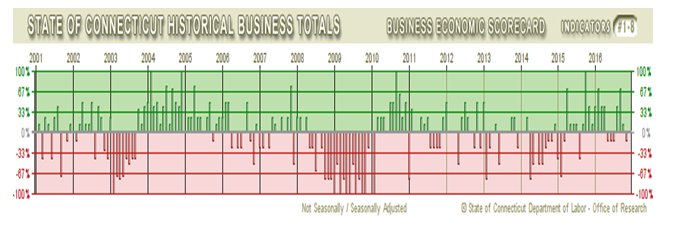
Stock Market
• Estimated and final income tax payments account for approximately 40
percent of total state income tax receipts. Both the estimated and final
payments had a negative rate of growth in Fiscal Year 2016.
• Two large quarterly estimated income tax payments for Fiscal Year 2017 have
been deposited. Estimated payments through February were down 8.6 percent from
last year. As can been seen from the graph, it is typical for final income tax
payments to follow the direction of estimated payments.
• The bulk of final payments will not be received until later in April. At that
time it is likely that current projections will be revised reflecting actual
collections in this volatile income tax component.
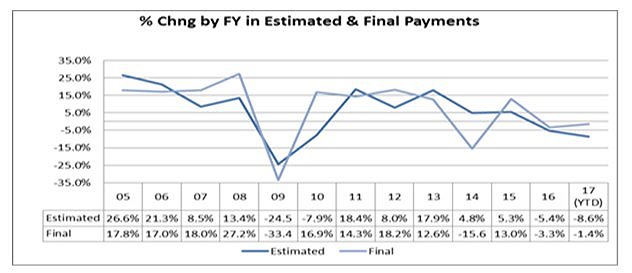
• The equity markets have experienced some recent volatility, but at this writing are showing year-to-date gains.
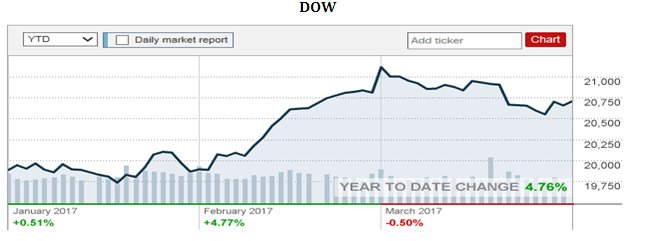
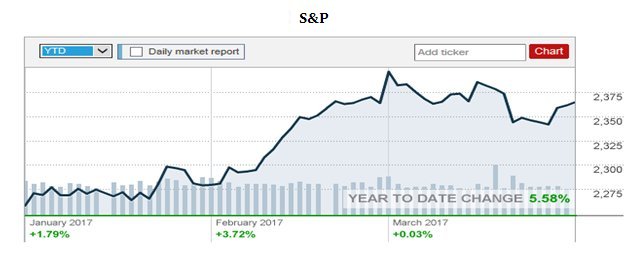
***END***
